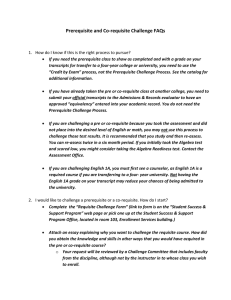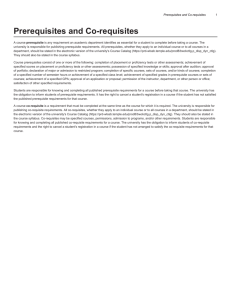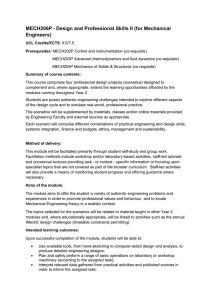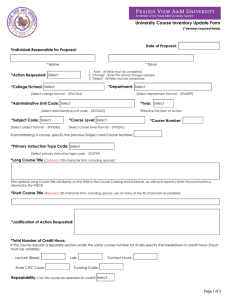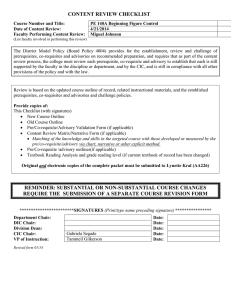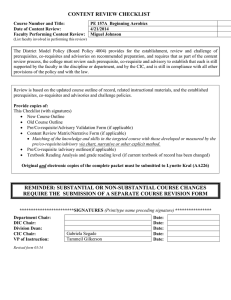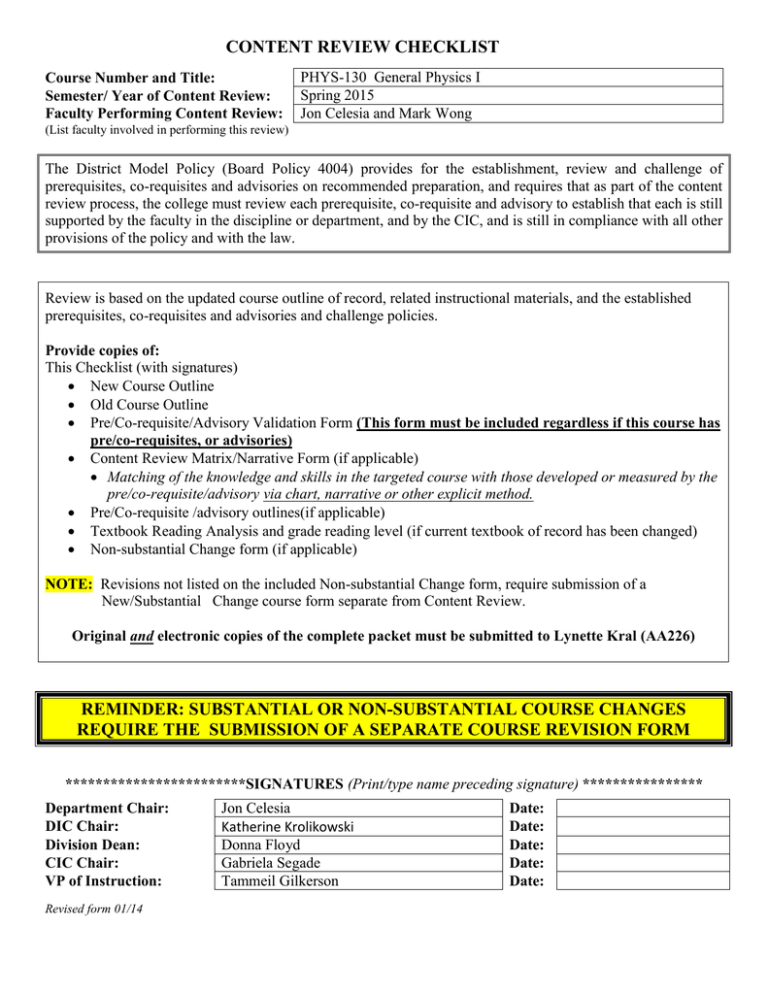
CONTENT REVIEW CHECKLIST
Course Number and Title:
Semester/ Year of Content Review:
Faculty Performing Content Review:
PHYS-130 General Physics I
Spring 2015
Jon Celesia and Mark Wong
(List faculty involved in performing this review)
The District Model Policy (Board Policy 4004) provides for the establishment, review and challenge of
prerequisites, co-requisites and advisories on recommended preparation, and requires that as part of the content
review process, the college must review each prerequisite, co-requisite and advisory to establish that each is still
supported by the faculty in the discipline or department, and by the CIC, and is still in compliance with all other
provisions of the policy and with the law.
Review is based on the updated course outline of record, related instructional materials, and the established
prerequisites, co-requisites and advisories and challenge policies.
Provide copies of:
This Checklist (with signatures)
New Course Outline
Old Course Outline
Pre/Co-requisite/Advisory Validation Form (This form must be included regardless if this course has
pre/co-requisites, or advisories)
Content Review Matrix/Narrative Form (if applicable)
Matching of the knowledge and skills in the targeted course with those developed or measured by the
pre/co-requisite/advisory via chart, narrative or other explicit method.
Pre/Co-requisite /advisory outlines(if applicable)
Textbook Reading Analysis and grade reading level (if current textbook of record has been changed)
Non-substantial Change form (if applicable)
NOTE: Revisions not listed on the included Non-substantial Change form, require submission of a
New/Substantial Change course form separate from Content Review.
Original and electronic copies of the complete packet must be submitted to Lynette Kral (AA226)
REMINDER: SUBSTANTIAL OR NON-SUBSTANTIAL COURSE CHANGES
REQUIRE THE SUBMISSION OF A SEPARATE COURSE REVISION FORM
************************SIGNATURES (Print/type name preceding signature) ****************
Department Chair:
DIC Chair:
Division Dean:
CIC Chair:
VP of Instruction:
Revised form 01/14
Jon Celesia
Katherine Krolikowski
Donna Floyd
Gabriela Segade
Tammeil Gilkerson
Date:
Date:
Date:
Date:
Date:
NON-SUBSTANTIAL COURSE/CATALOG CHANGE DURING CONTENT REVIEW
Please mark an "X" in the box of the item that has been revised.
X
Course Title
Course Description
Hours per term
Grade Option
Pre/Co-requisite/Advisory
X
X
Course Objectives/Course Content
Methods of Instruction
Outside Class Weekly Assignments
Instructional Materials
Student Evaluation
Reason for Change
CURRENT COURSE INFORMATION (Fill in the current department/course number/title and only areas that are being revised)
Course Number/Title:
PHYS-130 / General Physics I
Hours per semester:
Lecture:
Grade Option:
Letter
90
Lab:
36
HBA (Lecture):
Student Choice
HBA (Lab):
Pass/No Pass
Pre-requisite(s):
Co-requisite(s):
Advisory(ies):
CHANGE TO: Check box and fill in those parts that are being revised.
Course Title (limited to 39 character spaces):
Course Catalog Description: (Type new course description in expanding box below)
X
Hours per term:
Lecture:
54
Lab:
Grade Option:
Letter Grade
Prerequisite:
Delete:
Add:
Prerequisite:
Delete:
Add:
Co-requisite:
Delete:
Add:
Co-requisite:
Delete:
Add:
Advisory:
Delete:
Add:
72
Student Choice
HBA (Lecture):
Pass/No Pass
HBA (Lab):
This form must be included regardless if this course has pre/co-requisites, or advisories
CONTRA COSTA COLLEGE
PRE/CO-REQUISITE/ADVISORY VALIDATION FORM
[Use one validation form per pre/co-requisite, advisory except when Pre/Co-requisites are linked by “or” statements]
Course Number and Title:
PHYS-130 General Physics I
Pre/Co-requisite/Advisory to be validated:
X Yes
No
MATH-191
The department has reviewed each prerequisite, co-requisite, or advisory to
establish that each is still supported by the faculty in the discipline or department, or that the
student would not benefit from an additional prerequisite, co-requisite, or advisory to this
course. .
Content review is required for any prerequisite, co-requisite, or advisory to determine whether students
who do not meet the specified standard are highly unlikely to receive a satisfactory grade in the course
[Title 5, Section 55201 (b) (1]. This validation is separate from course approval. Additional scrutiny may be
required, depending on the type of pre/co-requisite.
Directions: Circle, or highlight one of the following and attach required justification AND content review
documentation.
1.
This course has no course pre/co-requisites or advisories.
2.
The course is an advisory only.
3.
This is a lab course. The primary course, ___________________, will have the validation evidence.
4.
This pre/co-requisite is required in order to make the course acceptable for transfer by the UC or CSU
systems. Attach documentation (catalog descriptions) from three or more UC/CSU campuses.
5.
This course is part of a sequence of courses within and/or across disciplines. Attach a copy of the course
outline that includes a list of the specific skills and knowledge that the student must possess to be ready
to take the course.
6.
The prerequisite is required for enrollment in a program.
Program name: ________________________ Program prerequisite(s) must be approved as provided for
at least one required course in the program, of which this is one. Attach copy of course outline
specifying skills and/or knowledge that student must possess.
7.
This prerequisite is required for the health or safety of the students in the course; students who lack this
prerequisite might endanger themselves or other students. Attach a copy of the course outline that
specifically lists what the student must possess before entering the course.
8.
This pre/co-requisite is required by law or government regulation. Attach a copy of pertinent law or
regulation.
9.
This pre/co-requisite is one of recency or another measure of readiness. Attach both a copy of the course
outline listing the specific skills student must possess AND data gathered as directed by the District
Model Policy.
10.
This prerequisite involves a limitation on enrollment. This includes auditions for performance courses,
honors courses or sections, and blocks of courses or sections created to set up a cohort of students (such
as PACE). Attach documentation as directed by pertinent sections of the District Model Policy.
***
NOTE: In addition to rigorous content review, an instructor may request a study of the empirical relationship between a
prerequisite course (or placement tool) and subsequent student performance in the targeted course. The rigor of content
review will be established on a college-wide basis in conjunction with District research requirements.
Revised form 01/14
CONTENT REVIEW MATRIX
FOR EVALUATING PRE/CO-REQUISITES/ADVISORIES
Pre/Co-requisites must have established challenge policies
Course Number:
Course Title:
Pre-requisite:
Co-requisite:
Advisory:
PHYS-130
General Physics I
MATH-191
Pre/Co-requisite Challenge Policy:
Departmental Exam or Proof of Completion of Equivalent Course
List skills/body of knowledge developed of course being reviewed: (APPLICABLE Course CONTENT)
1.
Topics of pre-calculus
2.
Limits and continuity
3.
Derivatives
4.
Integration
5.
Transcendental functions
6.
Techniques of integration
7.
Infinite series
8.
9.
10.
List exit skills of proposed pre/co-requisite: (APPLICABLE Course OBJECTIVES of pre/co-req./advisory)
Transcendental Functions - 25%
1.
a.
Exponential functions
b.
Inverse functions and derivatives
c.
Logarithmic functions, integrals
d.
Growth and decay
e.
LHospitals Rule
f.
Inverse trigonometric functions, derivatives and integrals
g.
Hyperbolic functions
Techniques of Integration - 25%
2.
a.
Basic Formulas
b.
Integration by parts
c.
Partial fractions
d.
Trigonometric substitutions
e.
Tables
f.
Improper integrals
Infinite Series - 25%
3.
a.
Sequences and series
b.
Comparison and integral tests
c.
Ratis and root tests
d.
Alternative series, absolute convergence
e.
Power series
f.
Taylor and Maclaurin series
Conic Sections, Parametric Equations - 25%
4.
a.
Conic section, the general quadratic
b.
Rotations
c.
Parametrization of curves
d.
Polar equations
5.
6.
7.
8.
9.
10.
Skills/body of knowledge
of course being reviewed
1.
1.
2.
3.
4.
5.
6.
7.
8.
9.
10.
Exit skills of proposed pre/co-req./advisory
2. 3.
4. 5.
6. 7.
8. 9. 10.
X
X
X
Or, list conclusions below regarding the necessity and appropriateness of the proposed pre-requisite, co-requisite, or advisory.
Math 191 is a pre- or co-requisite for Physics 130. As such, it carries the exit skills of Math 190 (the first course in the series),
which are found in the PHYS-130 entrance skills 1-4. Additionally topics that are covered in Math 191 may be learned
concurrently with the PHYS-130 topics and provide the foundation necessary to move forward in the physics and math series.
Revised form 01/14
Contra Costa College
Course Outline
Course Number
Course Title
Prerequisite
Challenge Policy
PHYS-130
General Physics I
MATH-191 (may be taken concurrently)
Departmental Exam or Proof of Completion of
Equivalent Course
Co-requisite
Challenge Policy
Advisory
*HOURS BY ARRANGEMENT:
Number of Weeks
Lecture Hours By Term
Lab Hours By Term
*Hours By Arrangement
Units
18
54
72
4
Hours per term.
ACTIVITIES: (Please provide a list of the activities students will perform in order to satisfy the HBA requirement):
COURSE/CATALOG DESCRIPTION
This course presents a lecture and laboratory study of mechanics and properties of matter, statics and dynamics of
translation and rotation, fluid mechanics, wave motion, and sound for students majoring in engineering, physics, and
chemistry.
COURSE OBJECTIVES:
At the completion of the course the student will be able to:
Apply Newton’s Force Laws to analyze problems.
Correctly apply the fundamentals of linear and rotational motion.
Demonstrate a basic comprehension of energy laws and conservation.
Explain the basic structure and nature of matter.
Apply the fundamental concepts of fluid pressure and Bernoulli’s Principle.
Demonstrate a basic comprehension of oscillations and wave motion.
Apply methods of calculus to analyze specific problems.
INTENDED STUDENT LEARNING OUTCOMES:
Students will be able to draw a free body diagram and use Newton’s Force Laws to analyze the object’s motion.
Students will be able to use conservation of mechanical energy to analyze the motion and position of an object.
Students will be able to analyze the motion of an object in SHM given the set of initial conditions.
COURSE CONTENT (Lecture):
Basic kinematics
Newton’s Laws
Work and energy
Momentum
Rotational motion
Statics
Gravitation
Fluid mechanics
Oscillations and waves
COURSE CONTENT (Lab):
Measurements and uncertainties
1-Dimensional motion graphs
Free Fall and incline plane
Newton’s Laws of motion
Atwood’s machine
Centripetal force
Ballistic pendulum
Moment of inertia and rotational energy
Static equilibrium
Hooke’s Law and simple harmonic motion
Archimedes’ principle
Standing waves
METHODS OF INSTRUCTION:
Lecture with demonstrations
Classroom discussions and activities
Problem solving
Laboratory experiments
Computer applications, including spreadsheets
INSTRUCTIONAL MATERIALS:
NOTE: To be UC/CSU transferable, the text must be dated within the last 7 years OR a statement of justification for a text beyond the
last 7 years must be included.
Textbook Title:
Author:
Publisher:
Edition/Date:
Justification Statement:
Textbook Reading Level:
Lab Manual Title
Author:
Publisher:
Edition/Date:
Physics for Scientists and Engineers: A Strategic Approach
Randall D. Knight
Pearson Addison-Wesley
3rd Edition / Copyright 2013
(For textbook beyond 7 years)
Contra Costa College Physics 130 Lab Manual
Contra Costa College Astronomy/Physics/Engineering/Geology Department
CCC Bookstore
Spring 2015
OUTSIDE OF CLASS WEEKLY ASSIGNMENTS:
Title 5, section 55002.5 establishes that a range of 48 -54hours of lecture, study, or lab work is required for one unit of credit.
For each hour of lecture, students should be required to spend an additional two hours of study outside of class to earn one
unit of credit.
Title 5, section 55002(a) 2F establishes that coursework calls for critical thinking and the understanding and application of concepts
determined by the curriculum committee to be at college level.
For degree applicable courses: List one example of critical thinking homework
Outside of Class Weekly Assignments
Hours per week
Weekly Reading Assignments (Include detailed assignment below, if applicable)
2
Chapter 7, Newton’s Third Law, pages 168 - 184
Weekly Writing Assignments (Include detailed assignment below, if applicable)
Weekly Math Problems (Include detailed assignment below, if applicable)
4
Problems and Conceptual Exercises, 5, 12, 16, 31, 33, 39, 43, 49, 55, and 57
Critical thinking homework example:
Using conservation of energy, calculate the velocity of the center of mass of a solid sphere after it has rolled a
distance s down a 30 degree inclined plane.
Lab or Software Application Assignments (Include detailed assignment below, if applicable)
Other Performance Assignments (Include detailed assignment below, if applicable)
STUDENT EVALUATION: (Show percentage breakdown for evaluation instruments)
Title 5, section 55002 (a) 2A establishes that the grade is based on demonstrated proficiency in subject matter and the ability to
demonstrate that proficiency.
For degree applicable courses: Course requires essay writing, or, in courses where the curriculum committee deems them
to be appropriate, by problem solving exercises, or skills demonstrations by students.
%
Essay
65
15
20
%
Computation or Non-computational Problem Solving Skills
%
Skills Demonstration
%
Objective Examinations
%
%
%
Other (describe)
Lab assignments
Homework
GRADING POLICY: (Choose LG, P/NP, or SC)
Pass / No Pass
X Letter Grade
90% - 100% = A
80% - 89% = B
70% - 79% = C
60% - 69% = D
Below 60% = F
70% and above = Pass
Below 70% = No Pass
Student Choice
90% - 100% = A
80% - 89% = B
70% - 79% = C
60% - 69% = D
Below 60% = F
Percentages vary from instructor
to instructor
or
70% and above = Pass
Below 70% = No Pass
Prepared by: Jon Celesia and Mark Wong
Date: Spring 2015
Revised form 09/14

